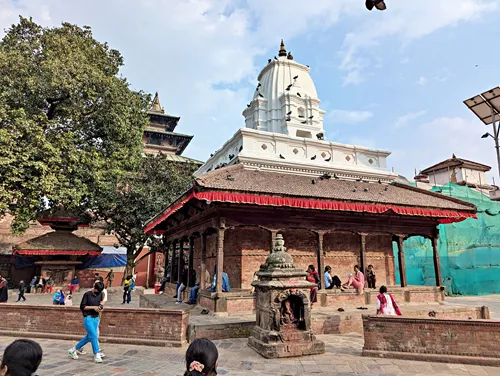Kageswor Mahadev Temple (Bhuvaneswara): Discovering Kathmandu's Crow Lord Shiva Shrine - Nepal Purple Travel Guide
(map, reviews)
This is Premium Content! To access it, please download our
Backpack and Snorkel Purple Travel GuideKeep walking north from Shree Kaal Bhairav Temple towards the temple with the white roof. This is Kageswor Mahadev Temple, also called Bhuvaneswara.
The temple is not open to visitors.

Here at Backpack and Snorkel Travel Guides, we typically promote self-guided walking tours.
But we realize that not everybody likes to walk by themselves in a foreign city. So, just in case that you rather go with ab guide: NO PROBLEM! Please see the Viator tours below.
free GuruWalk tours
paid Viator tours
Origin of the name Kageswor Mahadev Temple (Bhuvaneswara)
The temple's dual name reflects its rich spiritual identity. ‘Kageswor’ is a combination of ‘Kaga’ (meaning crow) and ‘Ishwor’ (a term for God), hinting at a divine connection with birds, especially the crow, which is a symbol often associated with Lord Shiva and the ancestral world.
The alternate name, ‘Bhuvaneswara’, translates to ‘Lord of the Worlds’, a grand title for Lord Shiva in his all-encompassing, cosmic form. Together, the names emphasize the temple’s spiritual breadth and deep cultural symbolism.
Architecture and Setting of Kageswor Mahadev Temple (Bhuvaneswara)
Though modest in scale, the temple features traditional Newar brickwork, a tiered roof, and intricate wood carvings that speak to the artistic heritage of the Malla period.
The white roof of Kageswor Mahadev Temple (Bhuvaneswara) in Kathmandu Durbar Square is an unusual feature that sets it apart from the more commonly seen red or dark tile roofs of other temples in the area. While there is no single definitive explanation recorded in historical texts, several interpretations can be drawn:
Symbolic Significance
In Hindu iconography, the color white often symbolizes purity, peace, and divinity. Since Lord Shiva is regarded as a meditative, ascetic deity who transcends worldly attachments, the white roof may represent his purity and cosmic wisdom. The whiteness might also reflect Shiva’s association with Mount Kailash, his mythical snowy abode, further reinforcing the divine connection to the color white.Connection to Bhuvaneswara Form
Since the temple is also known as Bhuvaneswara, or ‘Lord of the Worlds’, the white roof might symbolize universal purity or celestial association, giving it a divine, sky-like appearance—appropriate for a deity that transcends all realms.
Back to your self-guided tour
Author: Rudy at Backpack and Snorkel
Bio: Owner of Backpack and Snorkel Travel Guides. We create in-depth guides to help you plan unforgettable vacations around the world.
Other popular Purple Travel Guides you may be interested in:
Like this Backpack and Snorkel Purple Travel Guide? Pin these for later:





